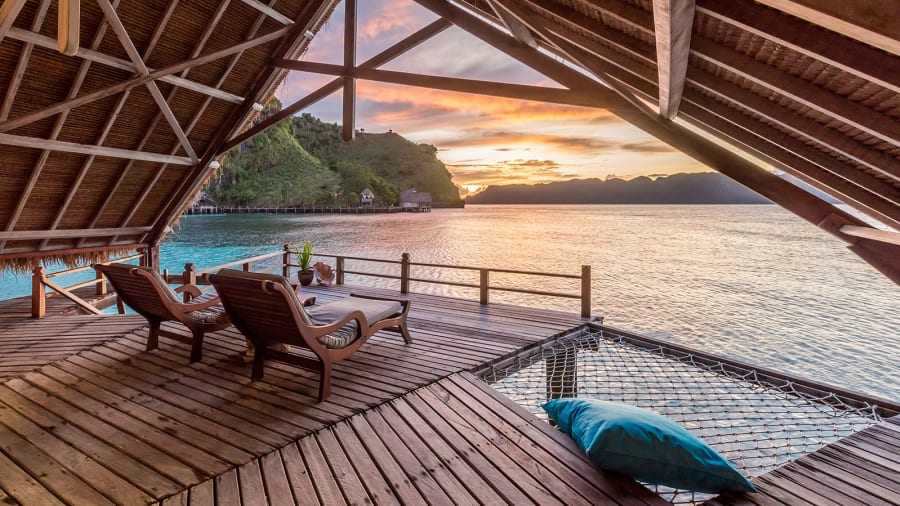Indonesia's Raja Ampat: 'The last paradise on Earth'

More than 30 years ago, Dutchman and history enthusiast Max Ammer received a lead from his then-landlord, a war veteran, about submerged WWII aircraft in the waters of Indonesia.
The tip led him to what would become a four-month-long diving expedition through various archipelagos, consulting local fishermen along the way.
During his journey, one place stood out from the rest: Raja Ampat, in Indonesia's West Papua Province.
Located in the heart of the Coral Triangle, the Raja Ampat Marine Protected Area Network spans over 4 million hectares and includes around 1,500 islands. Credited with having the richest marine biodiversity on Earth and a relatively remote location that has allowed it to escape mass tourism, it's no surprise that Raja Ampat is often marketed as "the last paradise on Earth." It's home to more than 1,600 species of fish, while some 75% of the world's known coral species can be found there.Read More : Indonesia to reopen Bali to some international flights Oct 14 "There are endless beautiful areas and many hundreds of beautiful coral gardens," says Ammer. His love for both the natural beauty and the local communities inspired him to open the Kri Eco Dive Resort in 1994, with the aim of training local divers and bringing people into the "unspoiled aquatic world." A resort at nearby Sordio Bay followed, with the two properties operating under Ammer's Papua Diving company.
Raja Ampat hasn't always been a conservation success story, proving that real change is possible with the right approach. "About 20 years ago, Raja Ampat was in decline because of unregulated commercial fishing and unsustainable practices," Meizani Irmadhiany, senior vice president and executive chair of Konservasi Indonesia, tells CNN Travel, citing shark finning and turtle poaching as examples.
"A lot needed to happen in partnership with various stakeholders to turn this around."
In 2004, Raja Ampat was added to West Papua's Bird's Head Seascape initiative, a project created to devise a network of Marine Protected Areas with the support of international conservators and local authorities. It strives to preserve marine resources while ensuring food security and sustainable economic benefits for the locals.
"Since the initiative's inception, fish populations have rebounded; poaching by outside fishers is down by around 90%; coral is recovering; and long-term food and livelihood security for local communities improved," says Irmadhiany.
Enticing local communities to become active members of the conservation effort has been key to its success.
The parks employ locals to survey and protect the areas. They preserve local indigenous knowledge, values and traditional practices such as "Sasi," which refers to the age-old local tradition of sequestering areas to allow ecosystems to recover.
"You've got to start with communities and ensure your solutions suit their needs. The goal is to support their self-determined commitments to protect their place, so the solution is sustainable and benefits local people and biodiversity," says Irmadhiany.
Their efforts are paying off. Earlier this year, the Raja Ampat Marine Parks Network -- which includes 10 protected areas spanning more than two million hectares -- was issued the Blue Parks Award.
Organized by Marine Conservation International and endorsed by the United Nations, the annual award recognizes marine parks around the world for meeting the highest science-based standards for conservation effectiveness.
The tip led him to what would become a four-month-long diving expedition through various archipelagos, consulting local fishermen along the way.
During his journey, one place stood out from the rest: Raja Ampat, in Indonesia's West Papua Province.
Located in the heart of the Coral Triangle, the Raja Ampat Marine Protected Area Network spans over 4 million hectares and includes around 1,500 islands. Credited with having the richest marine biodiversity on Earth and a relatively remote location that has allowed it to escape mass tourism, it's no surprise that Raja Ampat is often marketed as "the last paradise on Earth." It's home to more than 1,600 species of fish, while some 75% of the world's known coral species can be found there.
Raja Ampat hasn't always been a conservation success story, proving that real change is possible with the right approach. "About 20 years ago, Raja Ampat was in decline because of unregulated commercial fishing and unsustainable practices," Meizani Irmadhiany, senior vice president and executive chair of Konservasi Indonesia, tells CNN Travel, citing shark finning and turtle poaching as examples.
"A lot needed to happen in partnership with various stakeholders to turn this around."
In 2004, Raja Ampat was added to West Papua's Bird's Head Seascape initiative, a project created to devise a network of Marine Protected Areas with the support of international conservators and local authorities. It strives to preserve marine resources while ensuring food security and sustainable economic benefits for the locals.
"Since the initiative's inception, fish populations have rebounded; poaching by outside fishers is down by around 90%; coral is recovering; and long-term food and livelihood security for local communities improved," says Irmadhiany.
Enticing local communities to become active members of the conservation effort has been key to its success.
The parks employ locals to survey and protect the areas. They preserve local indigenous knowledge, values and traditional practices such as "Sasi," which refers to the age-old local tradition of sequestering areas to allow ecosystems to recover.
"You've got to start with communities and ensure your solutions suit their needs. The goal is to support their self-determined commitments to protect their place, so the solution is sustainable and benefits local people and biodiversity," says Irmadhiany.
Their efforts are paying off. Earlier this year, the Raja Ampat Marine Parks Network -- which includes 10 protected areas spanning more than two million hectares -- was issued the Blue Parks Award.
Organized by Marine Conservation International and endorsed by the United Nations, the annual award recognizes marine parks around the world for meeting the highest science-based standards for conservation effectiveness.
Source: edition.cnn.com
